The Rose-Ringed Parakeet (Psittacula krameri) stands as a captivating and widely recognized member of the parrot family, revered for its vibrant plumage and charming personality.
Originating from the Indian subcontinent, this species has successfully established populations across various regions worldwide, captivating bird enthusiasts with its adaptability and intelligence.
With its striking green body, rose-colored neck ring, and playful demeanor, the Rose-Ringed Parakeet has endeared itself to avian enthusiasts and casual observers alike.
However, its widespread presence has also sparked debates regarding its ecological impact and interactions with native bird species in some areas.
Through its resilience and captivating presence, the Rose-Ringed Parakeet continues to fascinate and intrigue bird lovers around the globe.
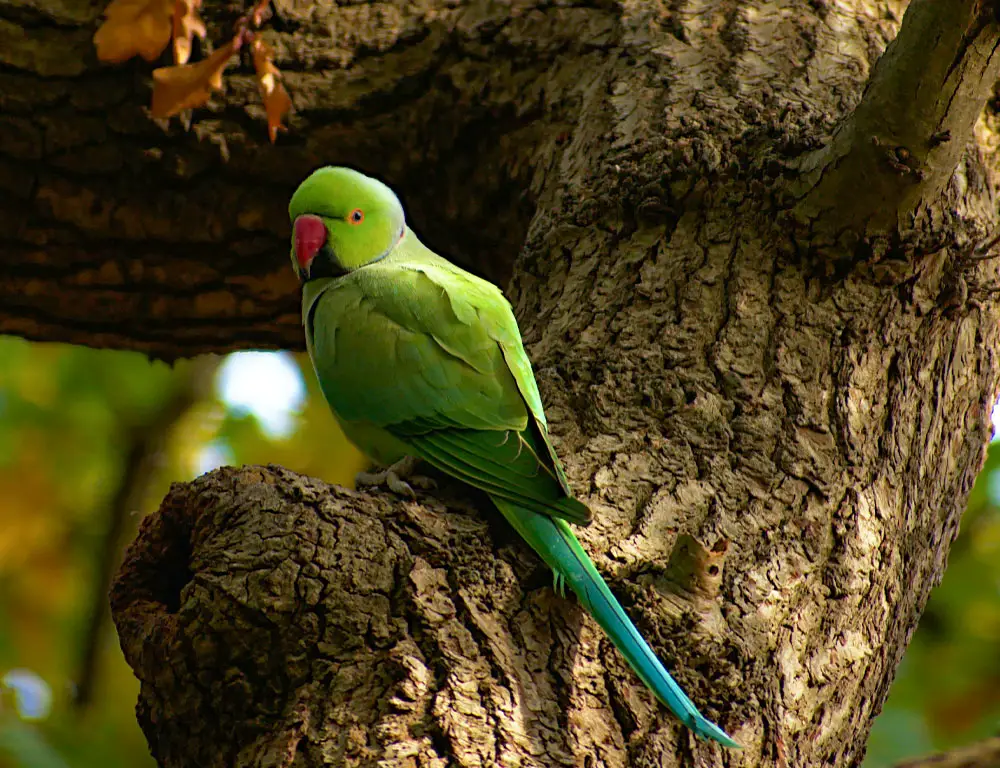
Significant Characteristics Of Rose-Ringed Parakeets
The Rose-Ringed Parakeet is a medium-sized and colorful bird that belongs to the family Psittacidae. It is native to Africa and Asia, inhabiting various habitats such as forests, woodlands, savannas, and urban areas.
It is also one of the most popular and widespread pet birds worldwide. Let’s discuss some essential characteristics of Rose-Ringed Parakeets.
Physical Characteristics Of Rose-Ringed Parakeet
Here are some of the physical characteristics of this charming and intelligent bird:
Size And Shape
The Rose-Ringed Parakeet is about 40 cm long and weighs around 100 g. It has a slender body, a long tail, a hooked bill, and zygodactyl feet. The tail is pointed and tapered, accounting for more than half of the body length.
The bill is curved and firm, adapted for cracking nuts and seeds. The feet have two toes pointing forward and two toes pointing backward, which help the bird to grasp and manipulate objects.
Color And Pattern
The Rose-Ringed Parakeet has primarily green plumage, with some variations depending on the subspecies and the region. The head and neck are pale green, with a black chin and throat.
The upperparts are dark green, with blue or turquoise tinges on the wings and tail. The underparts are light green, with yellow or orange tinges on the abdomen and under the tail.
The eyes are yellow, with a red or black eye ring. The bill is red, and the legs and feet are grey. The male has a distinctive rose-red ring around the neck, which gives the bird its name.
The female lacks the ring or has a faint or incomplete one. The juvenile is similar to the female but duller and more minor.
Sexual Dimorphism
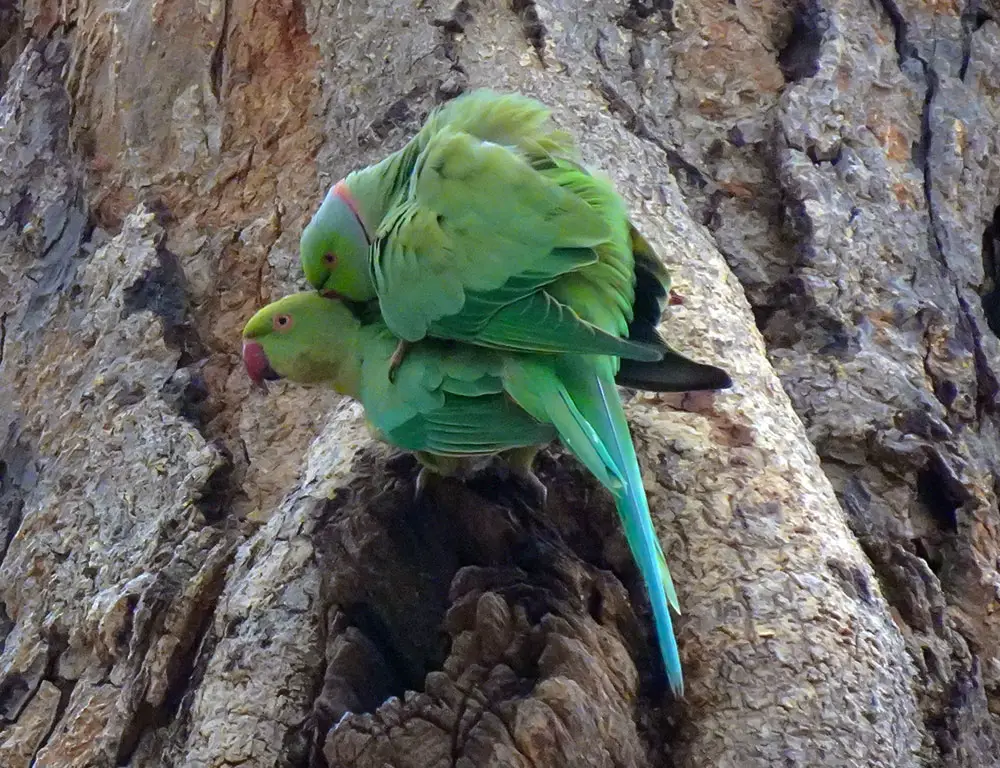
The Rose-Ringed Parakeet exhibits sexual dimorphism, which means that the male and female have different appearances. As described above, the male is more colorful and conspicuous than the female.
The male also has a more extensive and brighter bill than the female, which may help attract mates and display dominance.
Moult
The Rose-Ringed Parakeet undergoes a complete molt once a year, usually after the breeding season. During this time, the bird may lose some of its feathers, especially on the head and the neck.
The moult lasts about two months, and the bird regains its fresh and glossy plumage.
Voice
The Rose-Ringed Parakeet is a noisy and vocal bird that produces various sounds, such as chirps, squawks, whistles, and mimicry. The male sings more often and louder than the female, especially during the breeding season and early morning.
The song attracts mates, defends territories, and communicates with other birds. The bird can also imitate the sounds of different birds and animals and human noises such as words, music, and alarms.
It is one of the most talented and talkative parrots and can learn to speak hundreds of words and phrases.
Diet And Nutrition
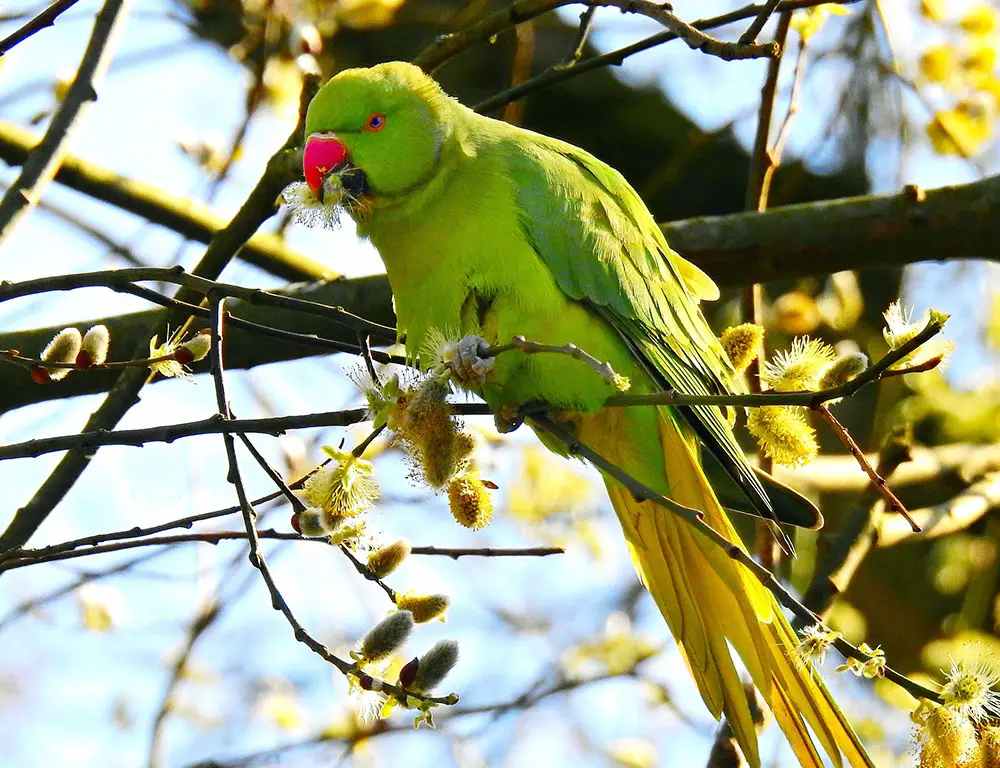
The Rose-Ringed Parakeet is mainly herbivorous, feeding on various plants such as seeds, nuts, fruits, berries, flowers, buds, and nectar. It also occasionally eats insects, worms, and small vertebrates such as lizards and mice.
The bird forages on the ground or in the trees, often in large flocks. It may also visit bird feeders or human settlements to find food. It needs to drink water regularly and may visit ponds, streams, or fountains to quench its thirst.
Reproduction
The Rose-Ringed Parakeet breeds from January to June, depending on the region. The pair forms a monogamous bond and defends a territory. The nest is built by both sexes, usually in a tree hole, an aperture, or a cavity.
The nest is made of wood chips, feathers, and other materials and lined with finer materials. The female lays 2 to 6 eggs, which are white and oval. The incubation period is about 23 to 25 days, and the chicks are altricial, which means they are blind, naked, and helpless at birth.
The female broods the chicks, and the male feeds the female and the chicks. The fledging period is about 7 to 8 weeks, and the young may stay with their parents for some time before dispersing.
Distribution And Habitat
The Rose-Ringed Parakeet has a natural range that covers most of Africa and Asia, from Senegal and Mauritania in the west to Myanmar and Vietnam in the east and south to Sri Lanka and the Maldives.
It has also been introduced to many other regions, such as Europe, North America, Australia, and the Middle East. It occupies various habitats, including forests, woodlands, savannas, and urban areas.
It prefers areas with trees and shrubs and avoids dense or arid regions. It can adapt to different climatic and environmental conditions and tolerate cold and heat.
Lifespan/Longevity
The Rose-Ringed Parakeet can live for up to 30 years in the wild and up to 50 years in captivity. It is one of the longest-lived parrots and can outlive many other pets.
It has a high survival rate and can cope with diseases and injuries. It can also age gracefully and retain its beauty and vitality until the end.
Behavior
The Rose-Ringed Parakeet is a social and gregarious bird that lives in flocks of up to hundreds of individuals. It is also a territorial and aggressive bird that fights with other birds and animals for food and space.
It is a diurnal and active bird that spends most of the day foraging, flying, and playing. It is also a curious and playful bird that likes exploring and manipulating objects.
It is a fast and agile flyer, which can reach up to 50 km/h. It can also climb and hang upside down, using its feet and bill.
Communication And Perception
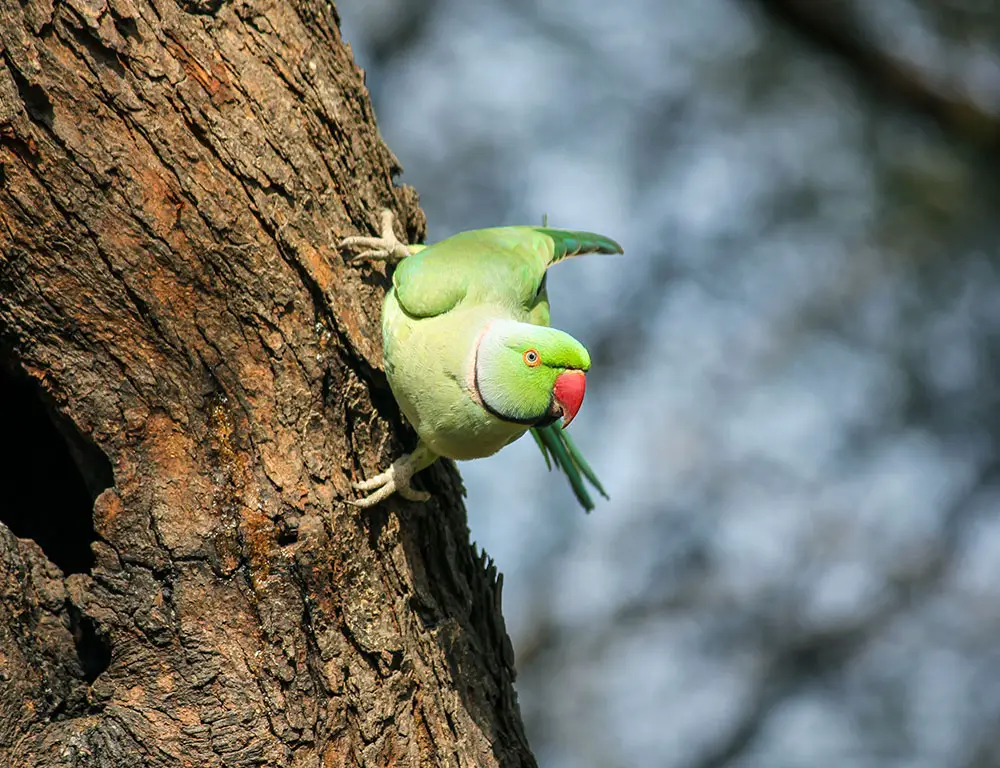
The Rose-Ringed Parakeet is a noisy and vocal bird that produces various sounds, such as chirps, squawks, whistles, and mimicry. The male sings more often and louder than the female, especially during the breeding season and early morning.
The song attracts mates, defends territories, and communicates with other birds. The bird can also imitate the sounds of different birds and animals and human noises such as words, music, and alarms.
It is one of the most talented and talkative parrots and can learn to speak hundreds of words and phrases. It can also perceive colors, shapes, sizes, and numbers and has a good memory and intelligence.
Taxonomy
Here’s a simplified table of the taxonomy of the Rose-Ringed Parakeet:
| Taxonomic Level | Classification |
| Kingdom | Animalia |
| Phylum | Chordata |
| Class | Aves |
| Order | Psittaciformes |
| Family | Psittaculidae |
| Genus | Psittacula |
| Species | Psittacula krameri |
This classification places the Rose-Ringed Parakeet within the animal kingdom (Animalia), the chordate phylum (Chordata), the class of birds (Aves), the order of parrots and cockatoos (Psittaciformes), the parrot family (Psittaculidae), the genus Psittacula, and the species Psittacula krameri.
Nesting Habit
Here’s a simplified table outlining the nesting habits of the Rose-Ringed Parakeet:
| Nesting Habit | Description |
| Nest Type | Both male and female parakeets work together to excavate the nesting cavity. |
| Nest Material | Wood chips, leaves, twigs, and other vegetation, often lined with feathers |
| Nest Location | Typically in tree hollows, palm fronds, or holes in buildings and cliffs |
| Nest Construction | Incubated by both parents lasts around 23 to 24 days |
| Nesting Season | Varied, often between December to March, depending on geographic location |
| Clutch Size | Usually 3 to 6 eggs, occasionally up to 8 eggs |
| Incubation | Chicks fledge after about 6 to 7 weeks but remain dependent for some time |
| Fledging Period | It can be high, though nest predation and human disturbance are common challenges |
| Nesting Success | Can be high, though nest predation and human disturbance are common challenges |
This table summarizes the nesting behaviors and characteristics of the Rose-Ringed Parakeet, providing insights into its reproductive ecology and habitat preferences.
What are some common Diseases and their Treatment of a Rose-Ringed Parakeet
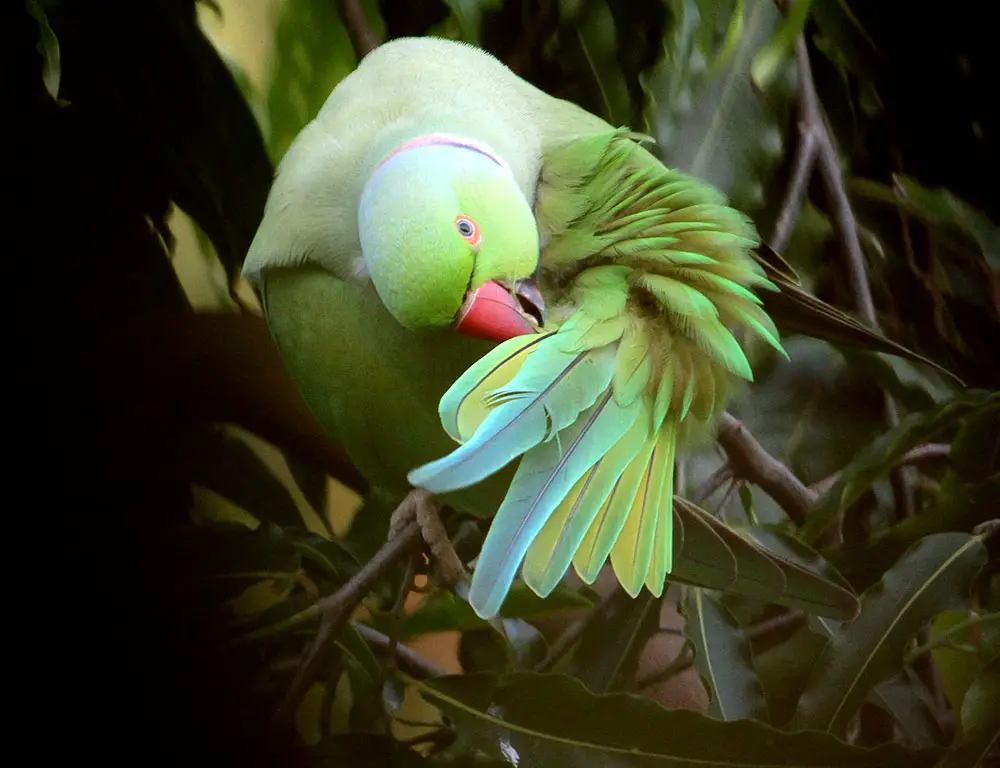
Like other pet birds, Rose-Ringed Parakeets can be susceptible to various diseases. Here are some common diseases that affect them and their treatments:
Psittacosis (Parrot Fever)
Symptoms
Respiratory distress, lethargy, nasal discharge, diarrhea, weight loss.
Treatment
A veterinarian prescribes antibiotics such as doxycycline or tetracycline. Isolation from other birds may be necessary to prevent transmission.
Aspergillosis
Symptoms
Respiratory distress, wheezing, coughing, lethargy, loss of appetite.
Treatment
Antifungal medications such as itraconazole or voriconazole and supportive care improve the bird’s overall health.
Polyomavirus
Symptoms
Regurgitation, weight loss, hemorrhages, delayed crop emptying.
Treatment
There is no specific treatment for Polyomavirus. Supportive care may include maintaining optimal nutrition, hydration, and warmth.
Psittacine Beak And Feather Disease (Pbfd)
Symptoms
Feather abnormalities, beak deformities, immune system suppression.
Treatment
There is no cure for PBFD. Treatment involves supportive care, maintaining good hygiene, and preventing secondary infections.
Bacterial Infections
Symptoms
Various symptoms depend on the affected system (e.g., respiratory, gastrointestinal).
Treatment
Antibiotics are prescribed by a veterinarian based on culture and sensitivity testing to target the specific bacterial strain.
Viral Infections
(e.g., Avian Polyomavirus, Avian Pox)
Symptoms
Depending on the virus, it may include lesions, respiratory signs, and neurological symptoms.
Treatment
Supportive care to strengthen the bird’s immune system and manage symptoms. Prevention through vaccination where available.
Gastrointestinal Disorders
(e.g., Clostridial Enteritis, Candidiasis)
Symptoms
Diarrhea, vomiting, abdominal pain, weight loss.
Treatment
Antimicrobial therapy, antifungal medications, probiotics, and supportive care to restore gut health.
It’s essential to note that early detection, proper diagnosis by a qualified avian veterinarian, and appropriate treatment are crucial for successfully managing diseases in Rose-Ringed Parakeets.
Additionally, maintaining good hygiene, providing a balanced diet, and regular veterinary check-ups can help prevent diseases and promote pet parakeets’ overall health and well-being.
Conclusion
The Rose-Ringed Parakeet exemplifies the intersection of beauty, adaptability, and controversy within the avian world. Its ability to thrive in diverse habitats and its endearing characteristics have earned it admiration and affection from bird enthusiasts worldwide.
However, its expanding populations in non-native regions have raised concerns about its potential impacts on local ecosystems and native bird species.
Despite these challenges, the Rose-Ringed Parakeet serves as a reminder of the complex dynamics between humans and wildlife and the importance of responsible pet ownership and conservation efforts to ensure the well-being of both native and introduced species in our ever-changing environment.